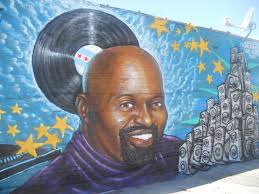by Ana Croegaert
My Vernacular Architecture Forum panel, “Architectures of Enjoyment,” was in many ways a departure from all of my previous scholarly conference presentations. I am an anthropologist by training—an ethnographer of migration and culture—and most of my research on the built environment has centered on the efforts of people displaced by the wars in former Yugoslavia to shape the landscape in their sites of relocation, as well as in their homeland. At times my work has included the small pleasures immigrants take in ćejf / pronounced “cheyf,” roughly translated as “to relish”: a coffee, a cigarette, or a leisurely stroll through the Chicago lakefront. More often, though, I have spent hours documenting and analyzing the impacts of schrapnel-ridden homes, bombed-out religious and cultural sites, and postwar political gridlock, on the well being of Bosnians and the postwar diaspora.
 Through this year’s VAF annual meeting, I was able to present new research that involves another set of migrations, and transformations of places: DJs and dance clubs. More specifically, House Music DJs and warehouses-turned-dance clubs. “House” music is an electronic music form innovated by Bronx-native Frankie Knuckles (Frank Warren) for primarily gay African-American and Latino clubgoers in Chicago’s post-industrial warehouse sites in the West Loop and River West parts of the city in the late 1970s / early 1980s. The music, and the “Warehouse”—the place where “House” music derives its name, and also the first club Knuckles DJ-ed before opening the “Power Plant”—quickly went international: the “Warehouse” club in Leeds, England opened in 1979. The “enjoyment” panelists’ presentations focused our attention on how people endeavor—and labor—to create places of recreation.
Through this year’s VAF annual meeting, I was able to present new research that involves another set of migrations, and transformations of places: DJs and dance clubs. More specifically, House Music DJs and warehouses-turned-dance clubs. “House” music is an electronic music form innovated by Bronx-native Frankie Knuckles (Frank Warren) for primarily gay African-American and Latino clubgoers in Chicago’s post-industrial warehouse sites in the West Loop and River West parts of the city in the late 1970s / early 1980s. The music, and the “Warehouse”—the place where “House” music derives its name, and also the first club Knuckles DJ-ed before opening the “Power Plant”—quickly went international: the “Warehouse” club in Leeds, England opened in 1979. The “enjoyment” panelists’ presentations focused our attention on how people endeavor—and labor—to create places of recreation.
John Kramer’s images created a visual narrative of Chicago’s men’s bowling leagues, and how these leagues served both as sociable spaces for working-class men (leagues were segregated by race, and sex) and as spaces in which to imagine class mobility through the aesthetics of Progressive-Era fitness paradigms, and capitalist-class private men’s clubs as manifested in the “Rec” center. Rosalynn and Adam Rothstein gave a thoroughly entertaining presentation on the “hexayurt” structure created by Vinay Gupta. While Gupta envisioned the hexayurt as a shelter that could be particularly useful in disaster relief settings, its most popular and prevalent use has been at the off-the-grid Burning Man annual outdoor festival held in Nevada’s Black Rock Desert. The Rothsteins traced the hexayurt’s evolution to a readily available pre-fab model, along with its own lexicon (I learned that hexayurt debris is referred to as “moop” or “matter out of place”!) as it has been appropriated as a showcase for DIY idealist architecture. Chad Randl’s comments on the papers posed stimulating lines of overlap and inquiry about how we might think about the ways that cultural and technological innovations precede, and leave their mark in, place-adaptations. I was still chewing on this food-for-thought when I attended another inspiring panel: “Roundtable on Latinos and the American Landscape”.
Here, Andrew Sandoval-Strausz, Sarah Lynn Lopez, and Mauricio Castro generated lively discussion peppered with critical commentary on the historical links established by North American and Caribbean Latinos on the North American architectural landscape. Sandoval-Strausz reminded us that Latino migrants in the U.S. have long been doing what urban planners in the 1980s coined “mixed-use” spaces, and “New Urbanism”. The central role of The Plaza in Latin American urban design is one among many such examples of urban living concepts Latinos have introduced to the United States. (I currently live in New Orleans, a U.S. city that has the mark of Latin-American / Anglo-American hybrid design in much of its landscape, starting with both a Plaza and a Central Business District). Castro provided a visual architectural genealogy of Miami, Florida and Havana, Cuba that helps us to better understand and to re-envision the renewed diplomatic and economic engagement between the United States and Cuba. Lopez’s presentation was of particular interest to me, as her concept of “the remittance landscape” and what she calls “the tyranny of maintenance” sets forth a model for better understanding the political economy of migration, and the work of long-distance belonging while embedded in a set of often precarious circumstances and state of well-being.
Together, these two panels reminded me of the promise that interdisciplinary research holds for helping us to grasp the empirical world, as well as to envision possible futures. The panelists took seriously the aesthetics of everyday people, including those of people from marginalized groups. They also placed these within a broader framework of inequality and class aspirations. Sandoval-Strausz’s remark about the New Urbanism challenges us to think critically about how processes of racialization and inequality not only significantly shape our built environments; they do so because they are enacted through a series of shifting symbolic—and ostensibly apolitical—aesthetics. Thank you VAF: it was my pleasure to participate in this year’s meeting!